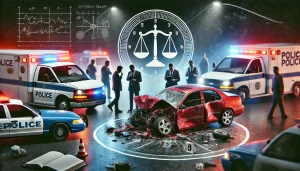 In the aftermath of a fatal motor vehicle accident involving a driver under the influence of drugs or alcohol, the time it takes for police or state attorneys’ offices to bring charges can be weeks or even months. This delay is due to the complexity of the investigation and the need for thorough evidence collection and analysis to build a solid case.
In the aftermath of a fatal motor vehicle accident involving a driver under the influence of drugs or alcohol, the time it takes for police or state attorneys’ offices to bring charges can be weeks or even months. This delay is due to the complexity of the investigation and the need for thorough evidence collection and analysis to build a solid case.
The Role of Evidence Collection
- Accident Reconstruction: After a serious accident, law enforcement agencies often conduct a detailed reconstruction of the incident. This process involves analyzing the crash scene, gathering data from the vehicles involved, and sometimes using 3D modeling to understand how the accident occurred. This can be time-consuming but is crucial for establishing factors like speed, vehicle positioning, and the sequence of events.
- Witness Statements: Collecting statements from witnesses, including passengers, bystanders, and other drivers, is essential. These statements can corroborate the sequence of events and provide insight into the driver’s behavior before the crash. Coordinating these interviews can take time, especially if witnesses are difficult to locate or uncooperative.
- Physical Evidence: Gathering and analyzing physical evidence, such as debris from the accident scene, vehicle damage, and skid marks, helps build a case. This evidence must be carefully documented and preserved to ensure it is admissible in court.
The Importance of Toxicology Reports
- Blood Alcohol Content (BAC) Testing: In Maryland, like in many states, a driver suspected of being under the influence must undergo blood, breath, or urine testing. The results of these tests are critical for establishing impairment. Blood tests, in particular, can take time to process, as they often require confirmation from certified labs.
- Drug Testing: Testing for drugs can be more complex than alcohol testing. It involves screening for a wide range of substances, each with its own detection methods and timelines. Confirmatory tests, which ensure the accuracy of initial screenings, can further extend the process.
- Chain of Custody: Maintaining a clear chain of custody for these samples is vital to ensure they are not tampered with and can be used as evidence in court. Any mishandling can result in the evidence being challenged or excluded.
Legal Procedures and Requirements
- Probable Cause and Charges: Before charges can be filed, the police must establish probable cause. This requires a comprehensive review of all collected evidence to ensure it supports the allegation of impaired driving leading to the fatality. Any gaps in the evidence can weaken the case, making it crucial to wait until the investigation is thorough.
- Review by State Attorneys: Once the police complete their investigation, the case is reviewed by the state’s attorney’s office. Prosecutors need to assess the strength of the evidence, consider potential defenses, and decide on appropriate charges. This review process involves legal scrutiny and strategic planning, often leading to further delays.
Maryland Laws and Procedures
In Maryland, the laws governing DUI-related fatalities are stringent, but they also require meticulous adherence to due process:
- Driving Under the Influence (DUI): Under Maryland law (Md. Code Ann., Transp. § 21-902), driving with a BAC of 0.08% or higher constitutes DUI. For controlled substances, any detectable level in the driver’s system can lead to charges if impairment is proven.
- Vehicular Manslaughter: When a DUI results in a fatality, charges can escalate to vehicular manslaughter (Md. Code Ann., Crim. Law § 2-209). This charge carries severe penalties, including imprisonment, making it imperative that the case against the driver is robust and irrefutable.
- Administrative Hearings: Drivers arrested for DUI in Maryland face administrative actions, such as license suspension, which occur independently of criminal proceedings. These hearings, conducted by the Motor Vehicle Administration (MVA), also require substantial evidence and proper documentation.
In Conclusion
The lengthy process of bringing charges in fatal motor vehicle accidents involving drugs or alcohol reflects the need for a meticulous and thorough investigation. The goal is to ensure that justice is served based on solid evidence, preserving the integrity of the legal process. In Maryland, the combination of detailed accident reconstruction, comprehensive toxicology testing, and rigorous legal procedures underscores the complexity of these cases and the importance of taking the necessary time to build a strong case.


